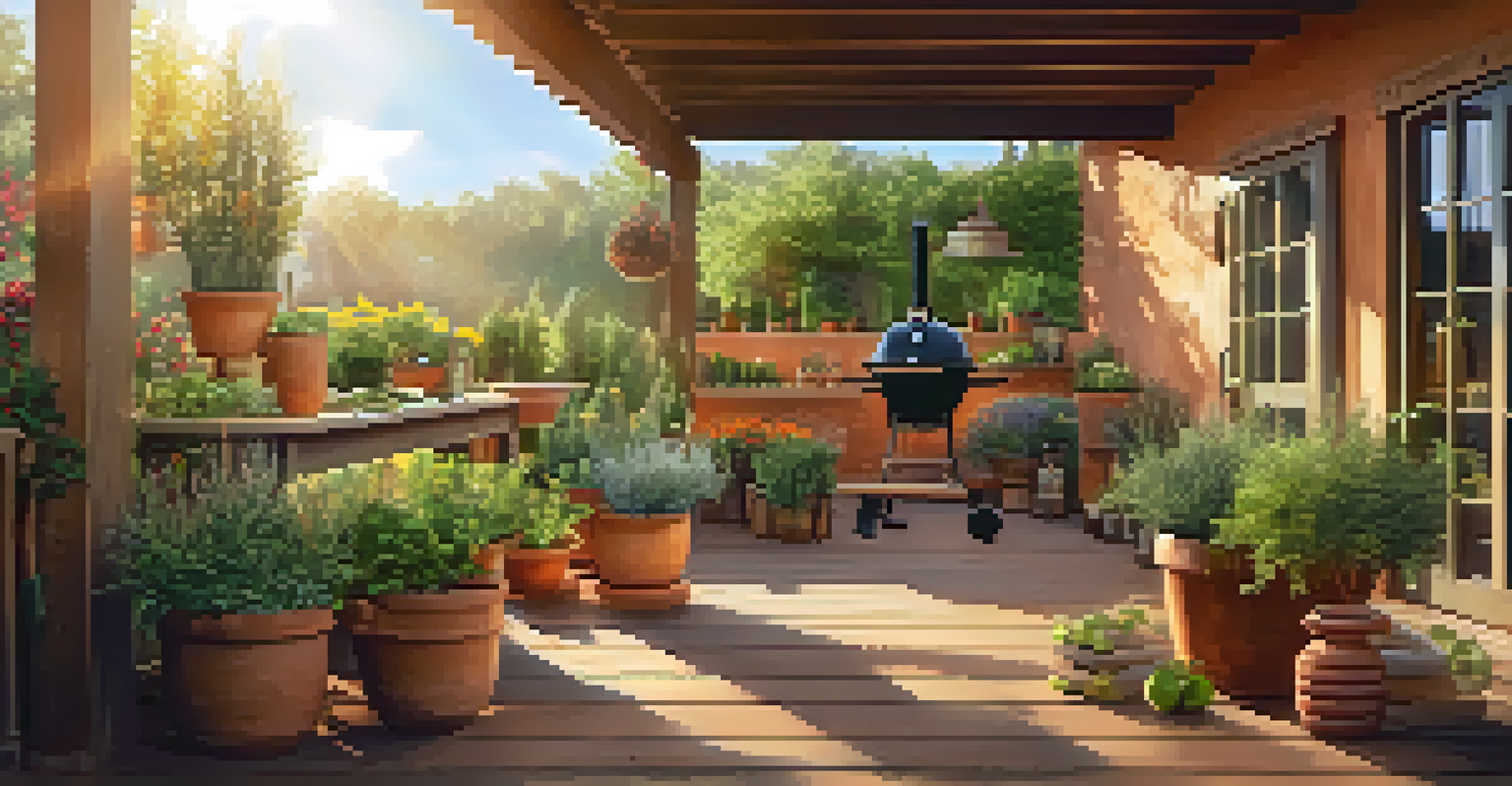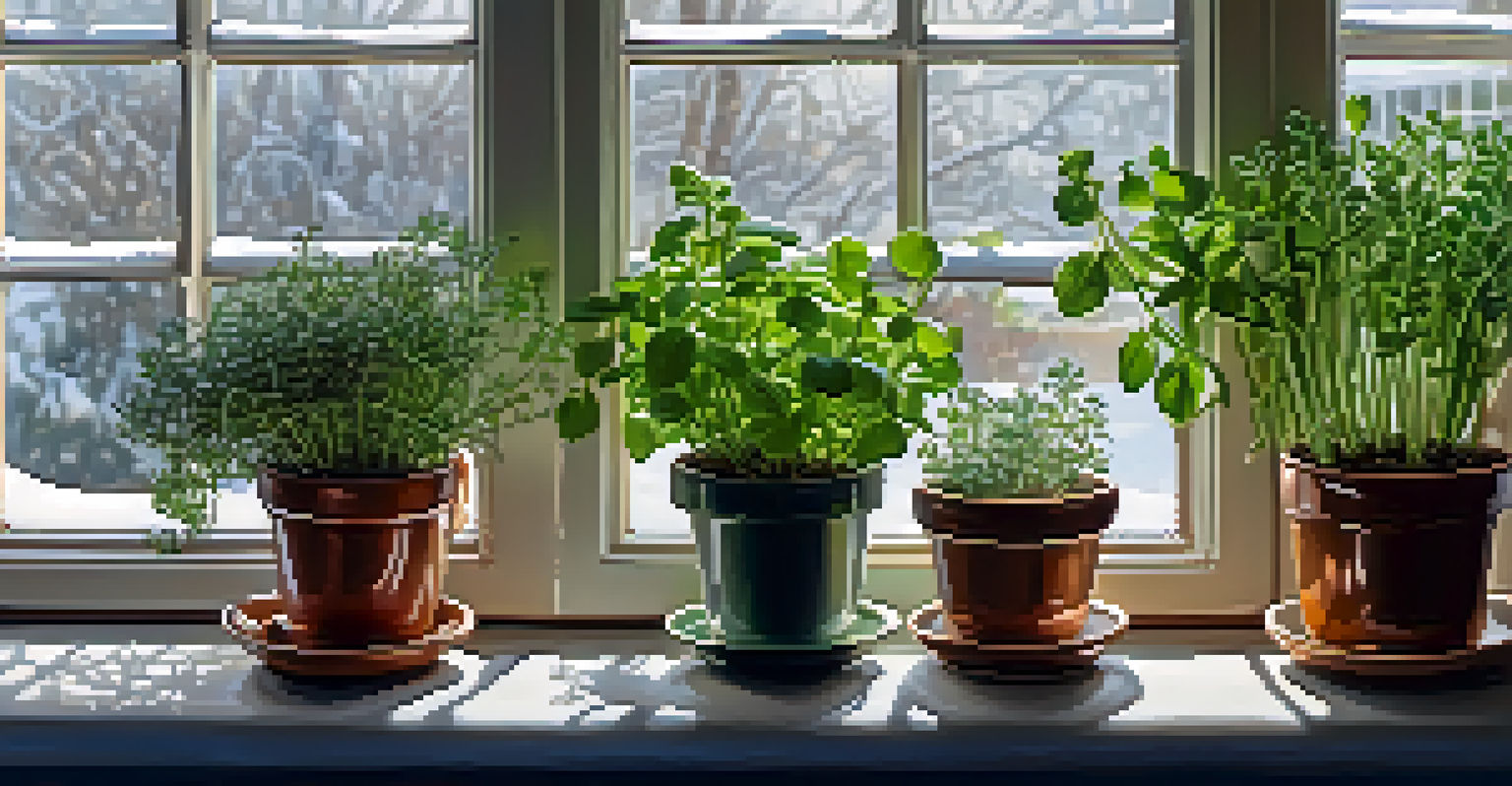Herb Planting Guide: Best Herbs for Each Season’s Growth

Understanding the Seasons for Herb Planting
Before diving into specific herbs, it's crucial to understand the seasons and how they impact growth. Each season offers unique conditions that can either promote or hinder the development of your herbs. Knowing when to plant is half the battle and can lead to a bountiful harvest.
The best time to plant a tree was twenty years ago. The second best time is now.
Spring is often viewed as the prime time for planting, as the soil warms and days grow longer. However, summer, autumn, and even winter have their own advantages when it comes to certain herbs. By aligning your planting schedule with the seasons, you ensure that your herbs thrive in their ideal conditions.
A seasonal approach not only maximizes yield but also enhances the flavor profile of your herbs. For instance, cooler weather herbs often flourish in late summer or fall, while others love the warmth of spring. Let's explore the best herbs for each season.
Spring: Ideal Herbs for Fresh Growth
Spring is a time of renewal, making it the perfect season to plant a variety of herbs. Basil, cilantro, and parsley are top choices that thrive in the warming soil. As the frost fades, these herbs can flourish, providing fresh flavors for your spring dishes.

Basil, with its fragrant leaves, is a favorite in many kitchens for making pesto or enhancing salads. Cilantro brings a burst of freshness to salsas and salads, while parsley can elevate nearly any dish with its vibrant green hue. Planting these herbs in early spring ensures you have them ready for summer cooking.
Seasonal Planting for Herb Success
Understanding which herbs to plant in each season ensures optimal growth and flavor.
Additionally, consider using companion planting techniques in your spring garden. For example, basil grows wonderfully alongside tomatoes, enhancing both growth and flavor. This spring, let your garden thrive with these aromatic choices!
Summer: Heat-Loving Herbs to Consider
As temperatures rise, so does the opportunity to plant heat-loving herbs like rosemary, thyme, and oregano. These hardy plants not only withstand the heat but also thrive in it, adding robust flavors to your summer meals. They’re perfect for grilling season, enhancing everything from meats to vegetables.
Gardening adds years to your life and life to your years.
Rosemary, with its woody stems and aromatic leaves, pairs beautifully with grilled dishes. Thyme is versatile, perfect for seasoning roasted vegetables, and oregano is a must-have for Italian cuisine. Planting these herbs in summer ensures you have fresh ingredients for your favorite recipes.
Summer planting can also be a great time to experiment with herb blends. Mixing different herbs can yield exciting flavors in your cooking. So, whether you're whipping up a barbecue or a fresh salad, don’t forget to include these sun-loving herbs!
Autumn: Harvesting and Replanting Opportunities
As the days grow shorter and the air turns crisp, autumn presents a unique opportunity for gardeners. While many might think it's time to pack up the garden, certain herbs like sage, chives, and mint thrive in cooler temperatures. This season is ideal for planting these herbs for future use.
Sage is a staple in autumn dishes, offering a warm, earthy flavor perfect for comfort foods. Chives add a mild onion flavor that complements soups and salads, while mint refreshes the palate in teas and desserts. Planting them in the fall allows them to establish roots before winter sets in.
Indoor Herbs Brighten Winter Meals
Growing herbs indoors during winter allows for fresh flavors in your cooking, regardless of the weather.
Moreover, autumn is also a great time to prepare your garden for the next growing season. Adding mulch or compost can protect your herbs and enrich the soil. Embrace the beauty of fall gardening; it can lead to delightful flavors in the winter months!
Winter: Indoor Herb Growing for Fresh Flavors
While winter may seem like a bleak time for gardening, it's actually an excellent opportunity to grow herbs indoors. Herbs like thyme, chives, and even basil can thrive in pots on your windowsill, providing fresh flavors right through the colder months. This way, you can enjoy homegrown herbs, regardless of the weather outside.
Indoor herb gardening requires a little extra care, especially in terms of light and temperature. Ensure your herbs receive enough sunlight, ideally 6-8 hours a day, and keep them in a warm area of your home. Regular watering is essential, but be cautious not to overwater, as this can lead to root rot.
Growing herbs indoors not only enhances your cooking but also brightens your space. Imagine the joy of snipping fresh basil for a winter pasta dish or adding chives to a warm soup. With a little attention, your indoor herb garden can be a thriving source of flavor all winter long.
Companion Planting: Boosting Your Herb Garden
Companion planting is a gardening technique that involves growing different plants in proximity for mutual benefits. In the herb garden, certain combinations can enhance growth, repel pests, and improve flavor. Understanding these relationships can lead to a more productive and flavorful garden.
For example, basil is known to enhance the flavor of tomatoes, while also repelling harmful insects. Planting it near tomatoes can lead to a bountiful harvest. Similarly, cilantro can help deter pests from attracting to your other herbs, making it a beneficial addition to your garden.
Companion Planting Enhances Growth
Strategically planting herbs together can boost growth, repel pests, and improve overall flavor in your garden.
By strategically placing your herbs together, you not only optimize your garden's health but also create a harmonious ecosystem. This approach is not only sustainable but also practical, ensuring that you enjoy the full potential of your herb garden all year round.
Maintaining Your Herbs: Tips for Thriving Plants
Once you've planted your herbs, proper maintenance is key to ensuring they thrive. Regular watering, adequate sunlight, and good soil are essential components of a healthy herb garden. Keeping an eye on your plants will help you catch any issues early on, ensuring a bountiful harvest.
It's important to remember that different herbs have different needs. For instance, basil loves moisture, while rosemary prefers drier conditions. Understanding these differences will help you cater to your herbs' specific requirements, leading to a lush and productive garden.

Additionally, regular harvesting encourages growth. Snipping off leaves not only provides you with fresh ingredients but also stimulates new growth. So, roll up your sleeves and get hands-on with your herbs; the more care you give, the more you'll receive in return!
Conclusion: Embrace the Herb Garden Journey
Creating a herb garden is not just about planting seeds; it's a journey filled with learning and growth. By understanding the best herbs to plant each season, you can cultivate a diverse and flavorful garden. Whether you’re a seasoned gardener or a beginner, there's always something new to discover.
As you plan your herb garden, remember the importance of timing, care, and companion planting. Each season offers its own opportunities for growth, and with the right approach, you can enjoy fresh herbs year-round. Plus, gardening can be a therapeutic activity, connecting you with nature.
So, grab your gardening gloves, choose your herbs, and start planting! With a little patience and enthusiasm, you'll soon be reaping the rewards in your kitchen and beyond. Embrace the journey, and let your herb garden flourish!